-
Posts
76 -
Joined
-
Last visited
Content Type
Profiles
News and Information
Tutorials
Product Reviews
Supplier Listings
Articles
Guitar Of The Month
Links and Resources
Forums
Gallery
Downloads
Posts posted by avdekan
-
-
34.625 for the E and 32.375 for the G. The "parallel" fret is about 7.25 (just past the 7th fret).
Thanks for all the comments so far... nice to see people getting interested in my build.
These numbers are quite unusual. I tried converting them into metric and the numbers behind the decimal point got even weirder. what made you go for these particular lengths?
-
Awesome bass! I like this calm but interesting design. And the wood choice mathes the design very well.
Can you say why have you chosen these pickups?
thanks, it's nice hearing positive responses.
about the pickups:
I wanted humbucking soapbars in there. didn't want to use EMG, and I figured that Bartolini will accentuate the already wery present (due to the wood selection) low-mids. So my dilemma was between Delano and Nordstrand.
In the end I went for the Nordstrands because of the j-bass vibe (it sounds quite similar to a j-bass pup when split), plus it looks fantastic

I think I will also give Delano a try in the future.
-
Very very cool.
what are the scale lengths?
-
this is the Chambered bass mkI
body:
hollow chambered Black limba / Imbuya top
wenge electronics cavity cover
neck:
Wenge / Ziricote fretboard
MOP side dots
bone nut
jumbo fretwire
double action truss rod
hardware:
Hipshot supertone bridge (optional strings through body)
Hipshot ultralight tuners
Schaller straplocks.
pickups:
Nordstrand dual coils
electronics:
series/split/parallel mini-switch for each pickup
active/passive circuit selector switch
passive circuit - volume, balance, tone
active circuit - ACG preamp - volume/balance, bass filter stack, treble filter stack
finish:
tru-oil

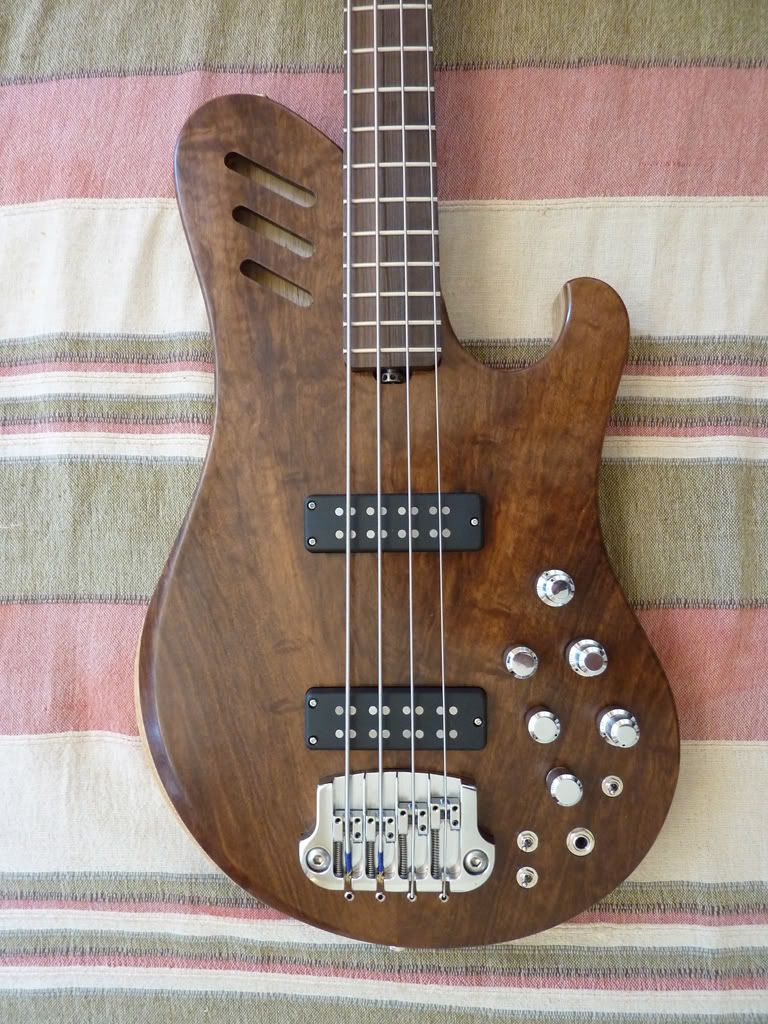

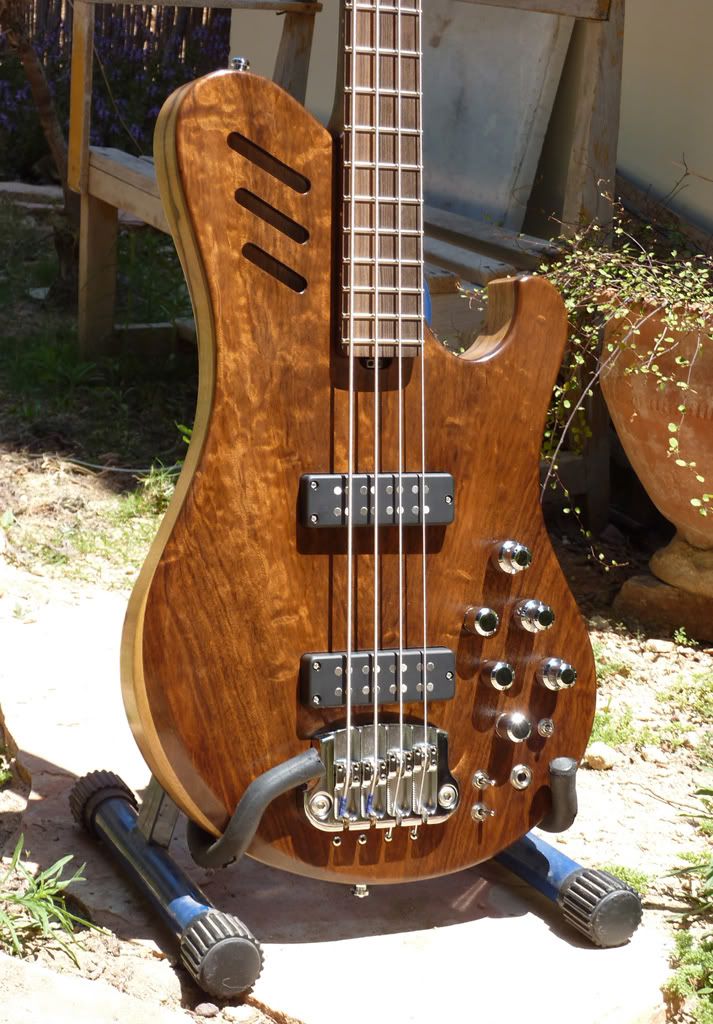
the building thread can be found here:
-
I finally finished it.
here are the specs:
body: hollow chambered Black limba / Imbuya top.
neck: Wenge / Ziricote fretboard, MOP side dots, bone nut, jumbo fretwire, double action truss rod.
hardware: Hipshot supertone bridge (optional strings through body), Hipshot ultralight tuners, Schaller straplocks.
pickups: Nordstrand dual coils.
electronics: series/split/parallel mini-switch for each pickup, active/passive circuit selector switch, passive circuit (volume, balance, tone), ACG active preamp (volume/balance, bass filter stack, treble filter stack)
finish: tru-oil
the sound is deep yet punchy (very deep-rounded bass with low-mid punch), a bit on the dark side (
 ) with the passive circuit, but the active preamp can twist the sound to be whatever you want it to be. I think it's nice to have two totally different "vibes" in the same instrument. overall I'm very pleased with how it sounds.
) with the passive circuit, but the active preamp can twist the sound to be whatever you want it to be. I think it's nice to have two totally different "vibes" in the same instrument. overall I'm very pleased with how it sounds.and here are some pics:


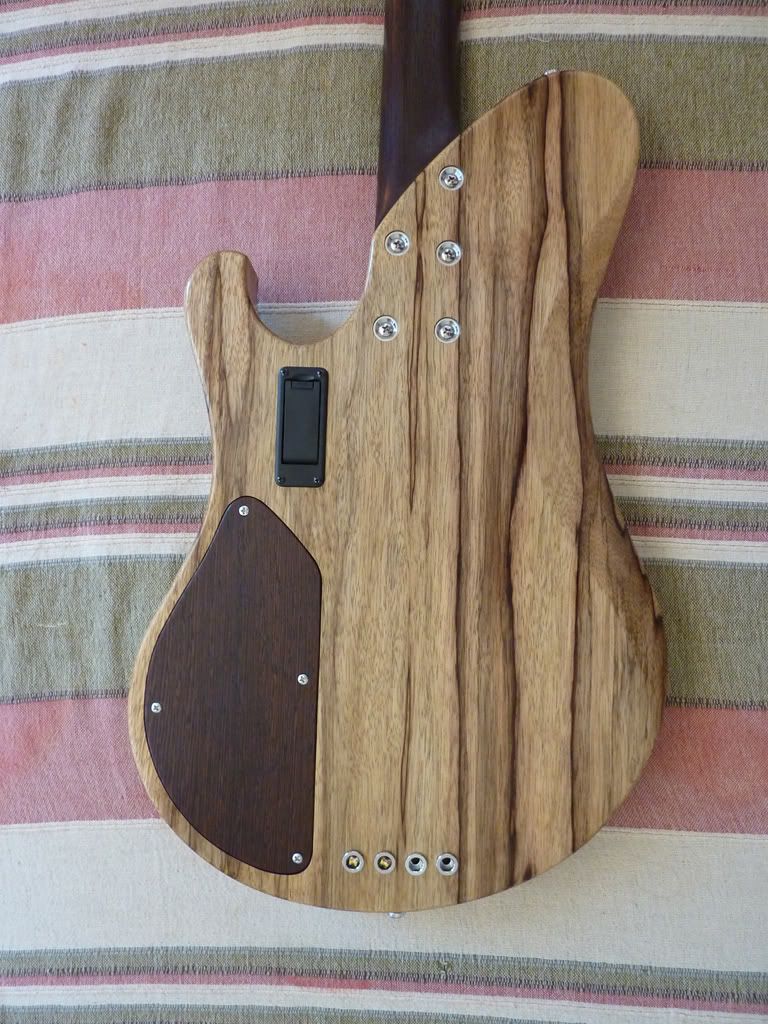


-
I reversed the wiring (after checking with the multimeter first - which I should have done in the first place) and it all works fine.
thanks for all your help.
B
p.s.
that was the last time I'm wiring a guitar without checking the components first.
lesson learned!

-
If its a dual-gang blend pot, where on one half the left lug is ground and the right is hot, and vice-versa on the other half, then a good candidate for the answer is that the ground and hot lugs are the wrong way round. You can try swapping the pickup and ground connections that you have from the inner half of the pot to the outer half, and outer to inner. Keep the diagonal X across the outer lugs.
The thing is, if its what Im thinking of, these pots have 50% of their track (say from left to centre) of very low resistance, and 50% where it builds up the reisistance to change the volume(say right to centre). The inner and outer halves are reversed left to right. So if you wire it right, in the middle position, both pups have a low resistance to hot and a high resistance to ground, and so both work. But if its the wrong way round, then the middle eposition gives both pups a low resistance to ground and high resistance to hot, hence no sound there, which is what you are describing.
John
I'll try to reverse the wiring today, hope it works.
thanks, B
-
I just finished assembling the bass I'm building at the moment.
All is working as planned accept for the blend pot (stewmac's), which is can select each of the two pickups (100% when fully turned to each side), but it's middle position is dead silent. from the middle position it functions as a volume pot to each side.
I did the standard X wiring for the outer lugs (green is going to the common ground and the pot's body, black is the live wire going to the volume pot), and the two live wires from the pickups are connected to the middle lugs.
There is no contact between the pot/wiring to the copper shielding.
can anyone tell what I'm missing here?
thanks, B
-
Almost done!
In the end I chose to go with a semi-semi-gloss (a bit more glossy than semi-gloss
 )
)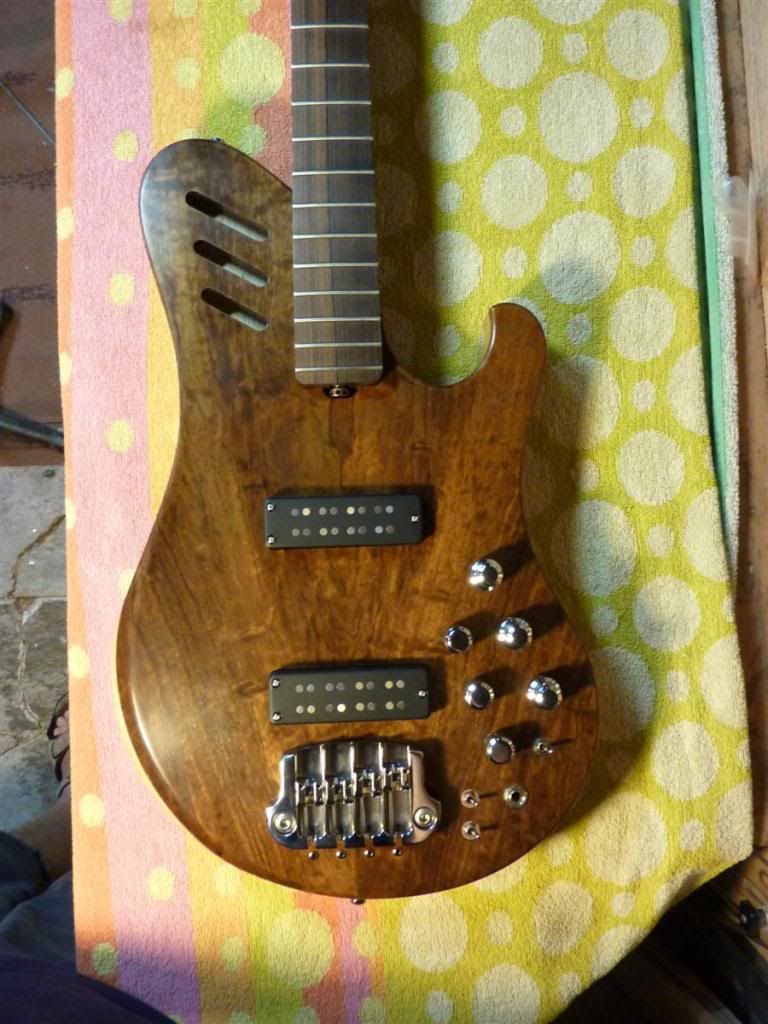
And here is the electronics cavity:
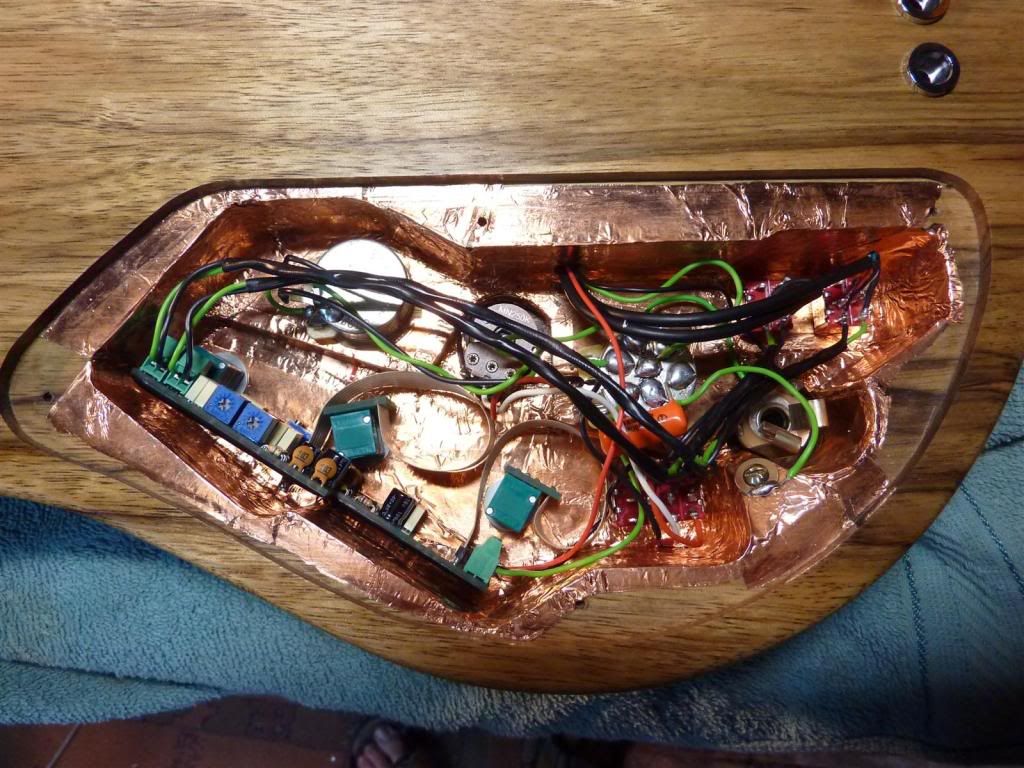
-
Is that bridge route for the Hipshot supertone bridge (or whatever it's called - their replacement for the old gibson bass bridges.) Curious as to your opinion on it, it's piqued my interest since I saw it.
It is a rout for a supertone bridge, and I haven't seen it in action yet because the bass is not finished, but I can give you my thoughts on it so far:
It's a big chunk of metal, bigger that I thought it would be, but surprisingly light for it's size (I think it's aluminum).
It's very well made (as are all of Hipshot's products I've seen so far) and the finish is very good.
The strings sit very high on this bridge (about 17mm going from memory) - hence the rout. I asked Hipshot for a dxf file of the bridge's outline so I could laser-cut a template and they were kind enough to send me the file right away. great customer service.
The underside of the bridge has three recesses (for the three original gibson studs), and it's mounted using only the rear two (I guess it's ok because the front end of the bridge is being pushed down by the strings). Because there is a ~3mm gap between the surface the bridge sits on and the floor of the recesses at the bridge's bottom, when I mounted the bridge onto the bass the screws pulled the bushings (which were sitting tightly in their holes) out. I think the recesses are necessary when you retrofit the bridge on a Gibson,but on a new build there is no point to them. I guess I'll just have to glue the bushings in place because of that.
-
Love the design.
This will be one sexy bass.
B
-
What does the guy want?
Personally, I like gloss.
-Stormy
the guy said "just do what you see fit".
to me the gloss finish, although looking very attractive, is a bit too "bling", while the semi-gloss has more "style" to it.
If the hardware was going to be golden, I think the gloss finish would be more true to its pimpish nature, but since he chose to go with chrome hardware in order to avoid this particular look, I think that satin finish would be more appropriate, so I'm leaning toward that option right now (although I realize it's the minority's opinion).
-
Now I'm in a dilemma.
I'm in the middle of building tru oil coats (7 so far) and I have two options:
finish the bass in gloss or semi-gloss.
in the semi gloss pictures the lighting makes it a bit blueish, but in reality it looks way better - darker brown with less orange in it than the gloss finish. the gloss pictures are more true to reality.
please share your thoughts on both options.
gloss:

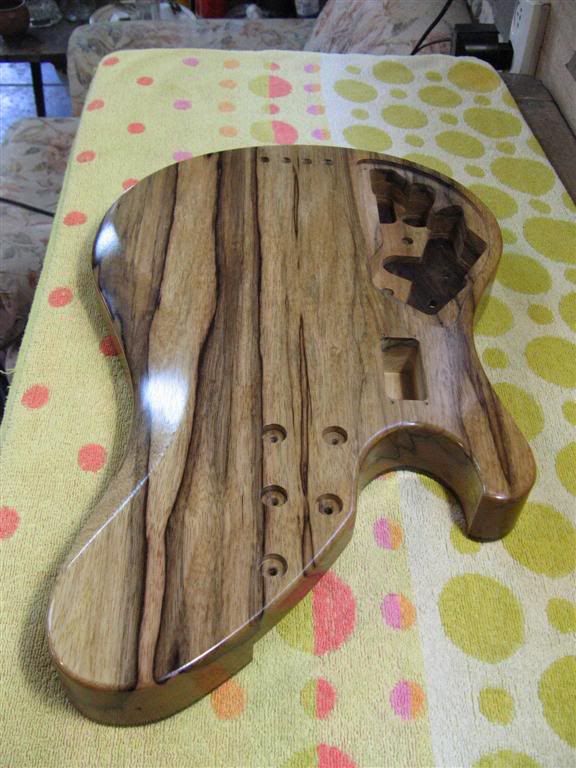
semi:

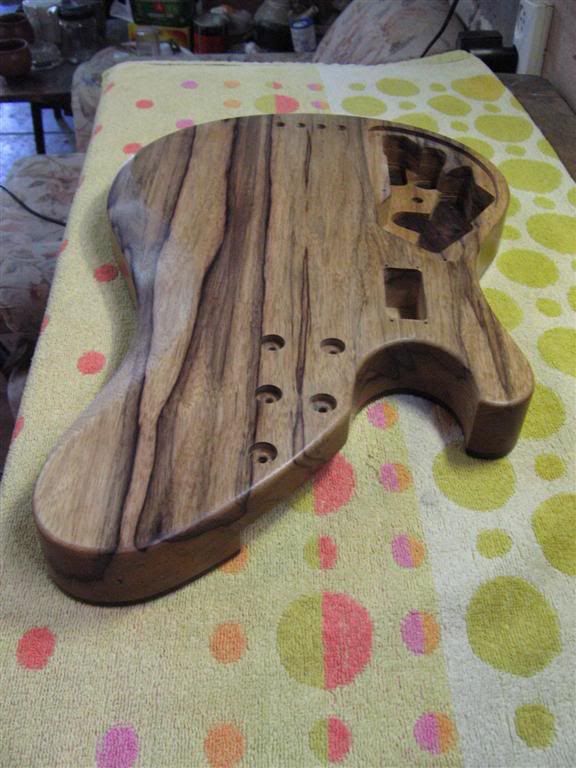
-
...Im afraid to ask what all of those knobs are going to be controlling....

The reason for all these knobs is the need for versatility as it's going to be my friend's only bass and he needs it for studio work.
there are two circuits on the bass that you can toggle between: an ACG preamp, and a standard passive circuit (volume/blend/tone). on top of that each pickup has a series/split/parallel switch that comes before the preamp selector switch. the last hole is the output jack.
personally, I would have gone with only the ACG preamp and the series/split/parallel switches, but my friend really wanted a passive circuit added - hence all the knobs.
-
Hi
This is my third "from scratch" project and my first (sort of) commission. I'm building it for a friend.
he wanted a simple, chunky, vintage vibe bass, and after several sketches and debates we decided on shape and specs.
The body is black limba with imbuya top, neck is bolt on wenge with ziricote fretboard. At the moment I'm applying tru oil coats, and will post the finished pictures and full specs when it is done.
In the meantime here are some building process pictures:
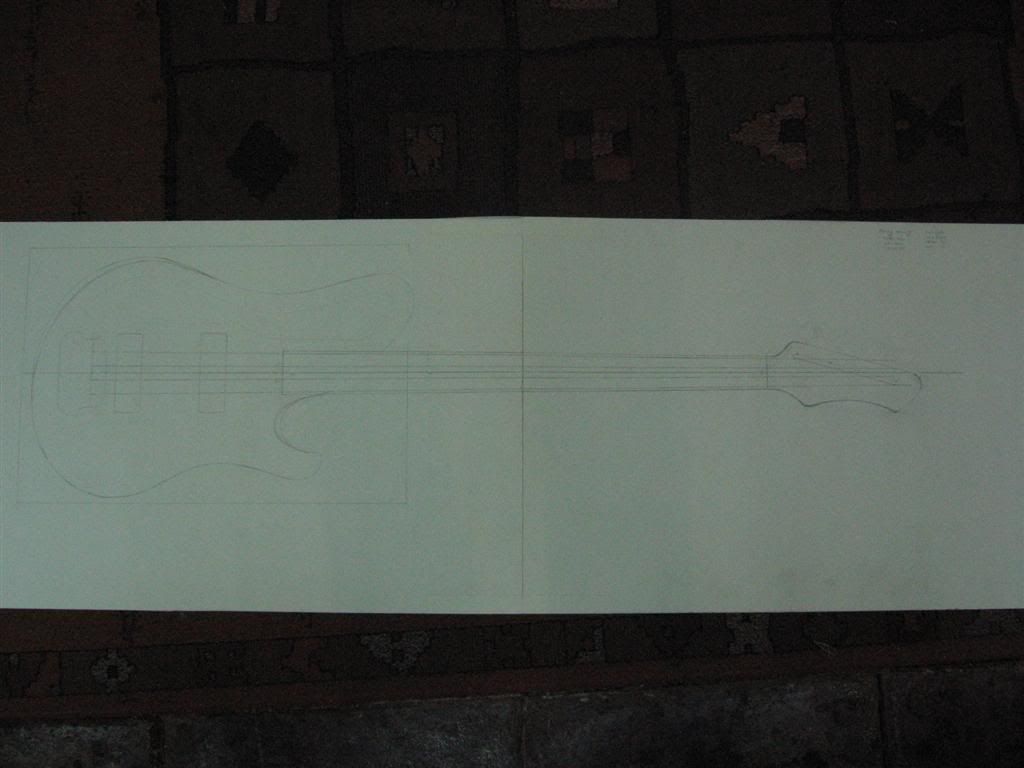
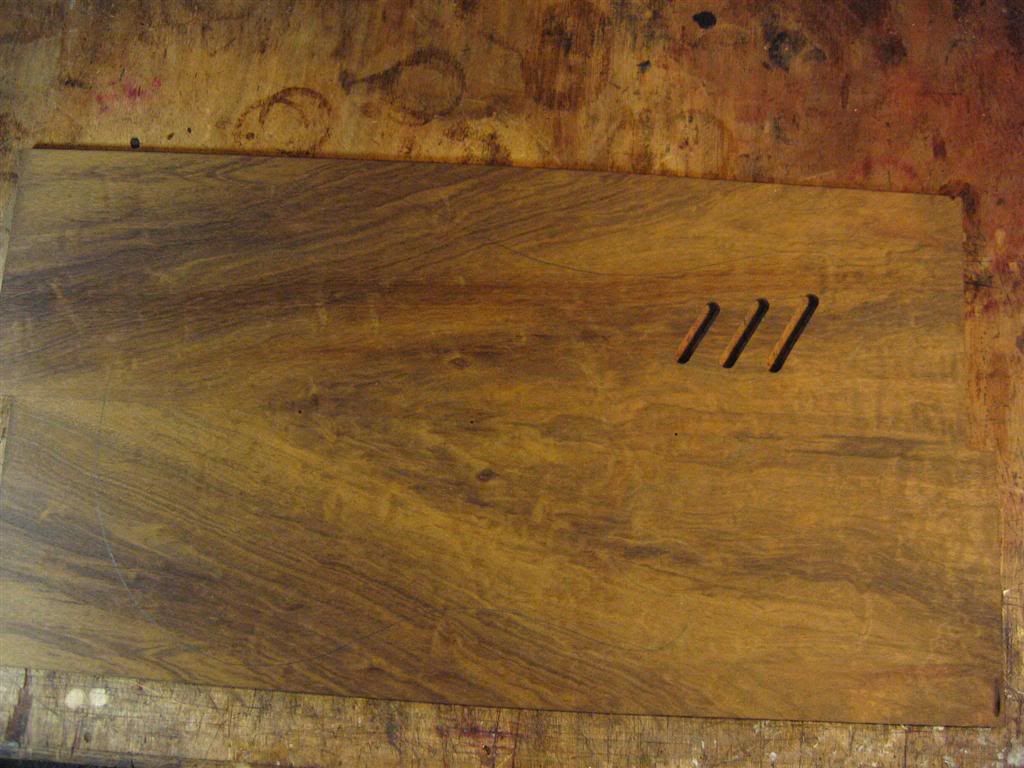
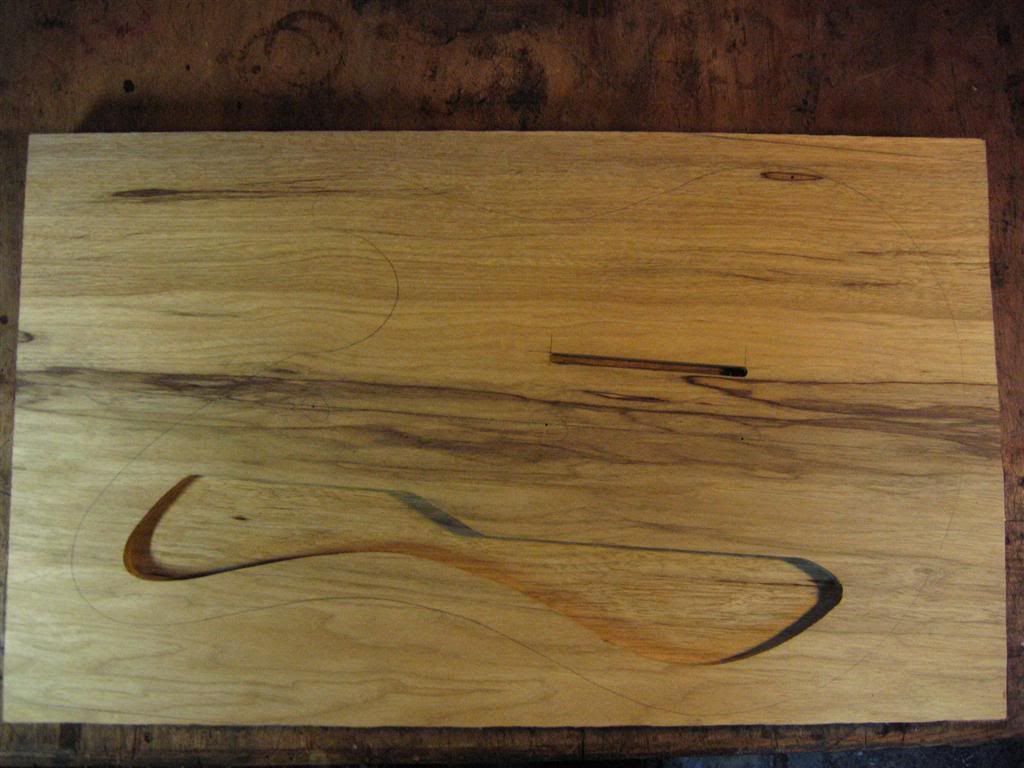

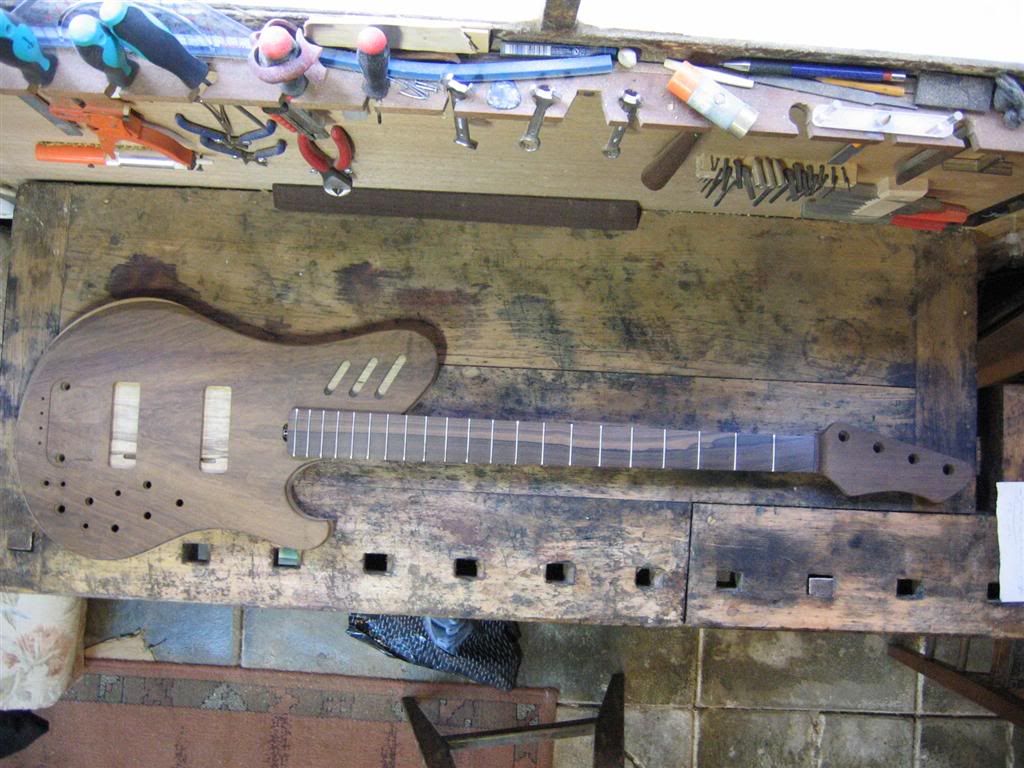
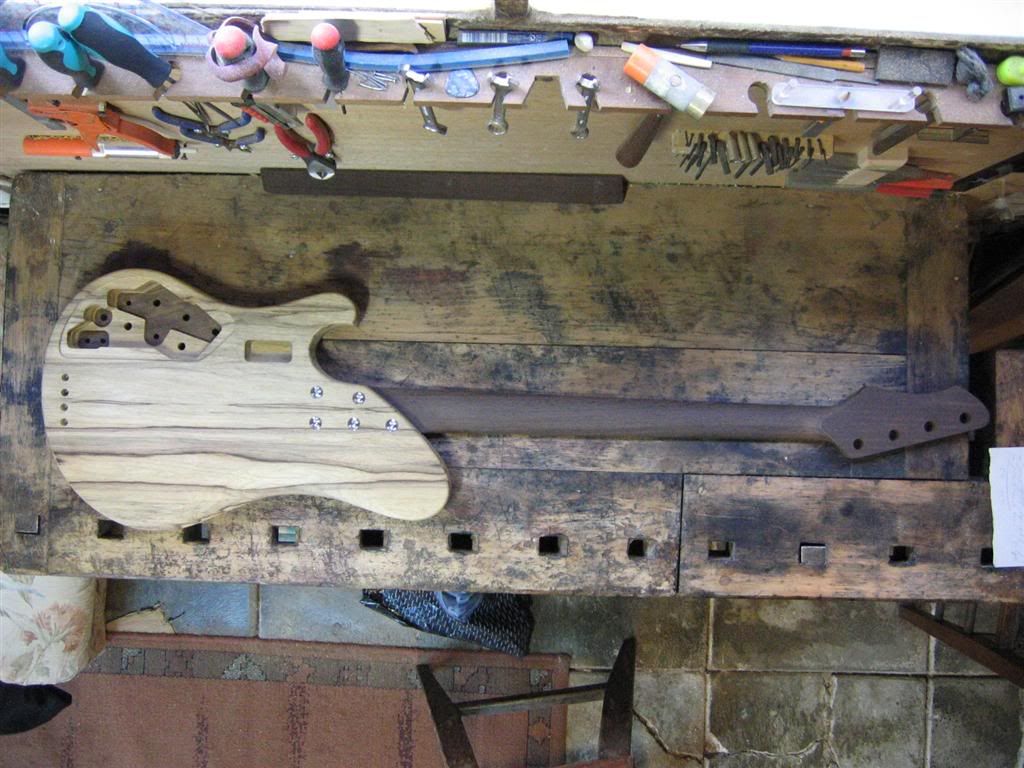
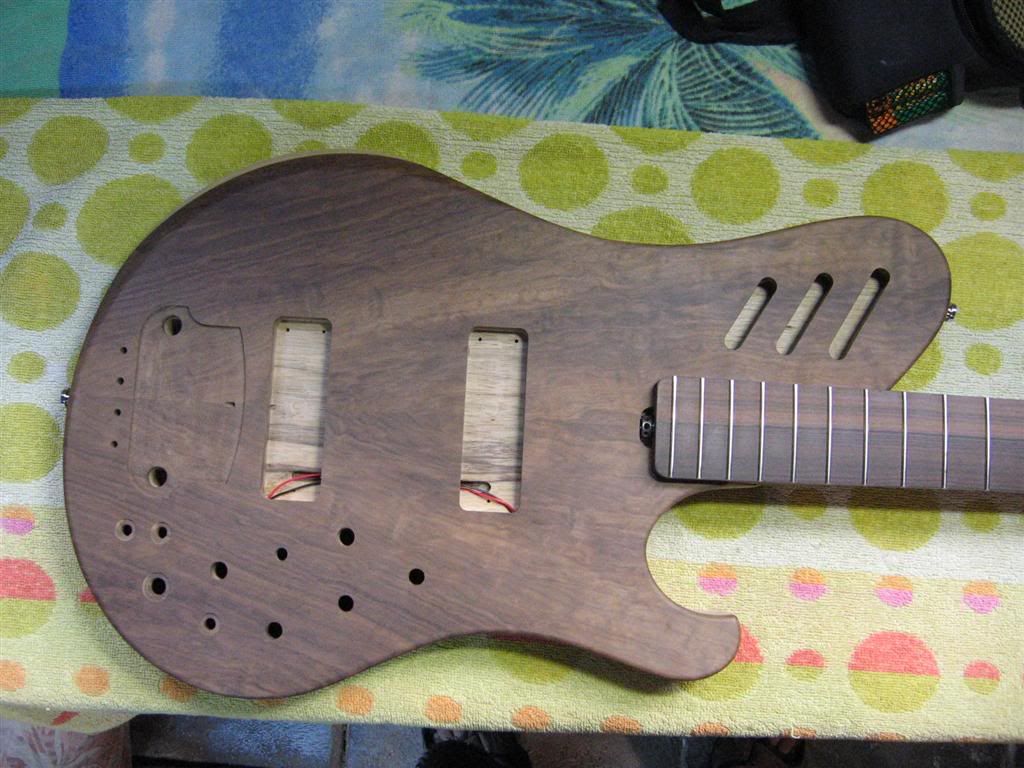


P.S.
I wanted to carve a recess at the heel but the friend to whom I'm building the bass objected, saying it will ruin the vintage vibe, and since he usually doesn't play at the higher register of the neck, high fret access was not an issue for him.
-
I recently read a post here that had groung loops discussed in it, and since I didn't want to hijack it i'm starting this one.
I have several problems with understanding this phenomenon. here are the issues I'm having trouble with:
1. I don't think I ever heard a guitar with ground loop problems. how do I diagnose a gound loop (by listening to the guitar)?
2. with all the strats and les pauls in the world that are both grounded via the pickguard shielding and star grounded working fine, how can guitar "ground loop" be a problem?
3. I understand how grond loops can happen in electricity networks when there is actually a ground, but to my understanding the guitar "ground" is actually the negative current that is ultimately connected to the other end of the speaker coil. how can ground loops occure in an ungrounded circuit?
disclaimer:
I know very little about electronics. I know the guitar wiring stuff and not much beyond it. I am in no way responsible for people suffering signal loss or being electricuted to death as a resault of me doubting the 11th commandment: "thou shalt not ground loop your guitar".

-
I think the first body shape is far better, anthough I would widen the bottom angle of the lower horn a bit so because it looks too square as it is.
-
I work at a piano restoration workshop and in the many years i've been there I've seen many black French polished pianos with ebonyzed veneers. they where all sort of "crisp" and crumbled really easily when handled in any way. It might be due to their age (60-120 years), but in my experience this process weakens the wood.
-
I'd say 3mm. maybe 2.5mm.
less than that and I'd start to get worried.
-
my first project was a 7 string neck through 2 piece rock maple neck made of 2 opposite rift-sawn pieces with no carbon fiber reinforcement. the neck was 17 mm at the 1st and 19 mm at around the 20th fret, and it is a very stiff neck.
you should take into account the weight of 2 truss rods, 3 carbon fiber reinforcements and 6 bass tuning machines. the neck might dive like a rock if you don't plan the body ro counterweight it.
considering how stiff rock maple is, I would easily use either 1 truss rod and 2 reinforcements or 2 truss rods and one reinforcement (either hardwood lamination or carbon fiber insert).
B
-
cheers!
B
-
Bolt-on neck? Shouldn't hurt anything.
Glue won't bond to it very well though, so keep it out of any future set neck pockets.
if glue won't bond tru oil finish well, should I avoid applying it inside the control cavity where I plan on sticking shielding tape?
-
I'm about to to start the finish on my 3rd project - a chambered 4 string bass.
It has a bolt on neck and I'm going tru-oil on this one. I know that when applying lacquer you should avoid getting it into the neck pocket because it will ruin the (supposedly perfect) match you have achieved between body and neck, and possibly damage vibration transfer between them. I don't see that happening with tru oil.
so the question is;
Is it safe to apply tru-oil in the neck pocket or should I leave it oil free?
Cheers,
B
-
Avdekan- That thing is sick. I love the design cause its different but not too radical. It looks like it has exactly what i want when it comes to the cutaways. The only thing i would change if i were to attempt it is the back area behind the bridge wouldn't be cut out as much. I'm really considering a design like that. It looks like you did a great job with it. It looks ridiculously clean and well built. What kind of finish did you use?
thanks man.
the finish is 3 coats of matte polyurethane lacquer. it was just enough to seal & protect the maple while leaving the wenge open-grained (oil-like finish).



Electrice Guitar Neck With French Polish
in Inlays and Finishing Chat
Posted
I've never french-polished a guitar but I do have a lot of experience with applying it.
In my experience french polish is very moisture sensitive, and will not be very effective if used on a guitar that is subject to sweat, beer etc. It is also a very hard finish, but since It's so thin (which is part of what makes it so appealing) its mechanical damage protection is low.
If it was to be a strictly-studio instrument I would consider it as an option, although I remember coming across a franch polished classical guitar that was pretty new and well taken cared of, in which the back of the neck's finish had develop a coarse texture as a result of the player's palm-sweat.
Hope that helps,
B